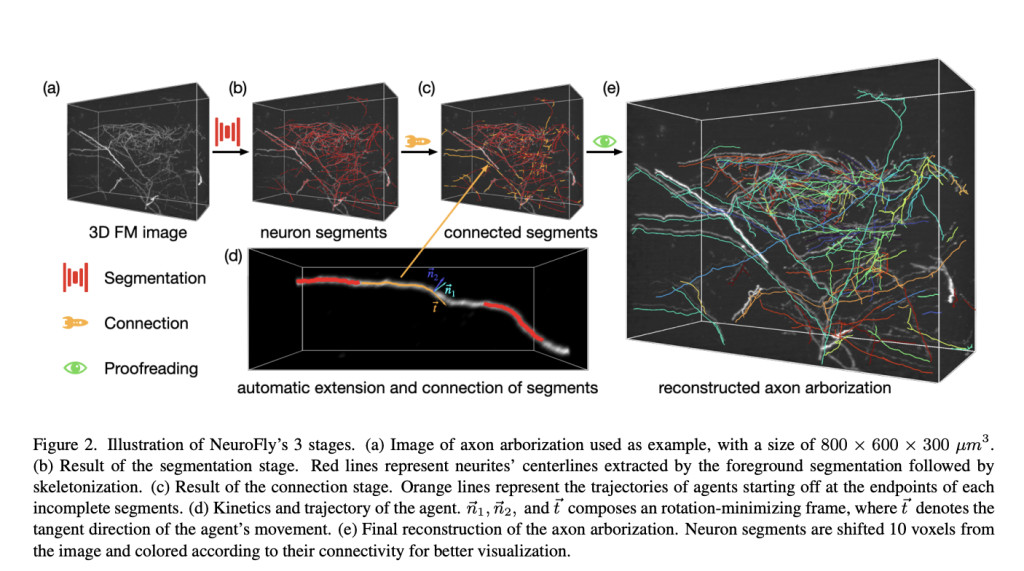

Neuroscience has advanced significantly, allowing us to understand the mapping of neurons in the brain. Neurons have dendrites and axons, branch-like structures connecting the neurons. Understanding these mappings is crucial for uncovering how the brain processes information, supports cognition, and controls movement, which have implications in neuroscience research and neurological disorder treatment. Mesoscale imaging is an advanced technique that has enabled us to understand these neuronal pathways. Despite being advanced, building a connectome, comprehensive brain map is challenging as it is a highly intricate and time-consuming process. For instance, a single mouse neuron can take up to 20 hours to map manually, making creating full brain-scale maps for even one species nearly impossible without automated solutions. A team of researchers has developed an innovative framework, NeuroFly, that efficiently automates neuron reconstruction.Â
Earlier initiatives, like the DIADEM challenge and the BigNeuron project, significantly advanced the neuron reconstruction process but faced a heavy challenge with complex and large-scale datasets. The DIADEM challenge aimed to benchmark the neuron reconstruction algorithms using standardized datasets. However, it could not fully account for the scale-up required to asses the terabytes of data for full-brain reconstruction. The BigNeuron project, building upon the DIADEM challenge, further standardized the protocols and evaluation methods. The intricate neuronal details needed more real-world imaging scenarios that this algorithm could not accommodate.Â

The NeuroFly contributions are as follows:
- Streamlined Segmentation, Connection, and Proofreading Pipeline: NeuroFly formulates the neuron reconstruction task as a structured workflow composed of three key stages:
- Segmentation: Neuron structures are isolated from surrounding brain tissue in the 3D image and identified using advanced automated techniques. These neuron fragments are not yet fully formed.Â
- Connection: NeuroFly utilizes a 3D image-based path-following method to connect these segments to form fully functional neurons. This technique also accounts for incomplete data or breaks in the images.
- Proofreading: This is the last but crucial step, as humans proofread these segments and their respective connections to eliminate the chances of errors.
- Model-Specific and Extendable Datasets: Neuronal connections vary from species to species and in different brain regions. This prompted the researchers to include diverse datasets, including various imaging methods and biological contexts. Additionally, the data was collected following a strict protocol, which allows the addition of new species or imaging techniques in the future.Â
- 3D Image-Based Path Following: Traditional methods struggled with the issue of gaps in neuron connectivity in the data. By using the 3D image-based path following, NeuroFly has facilitated the construction of incomplete neuronal pathways. This technique sends tiny virtual agents along the ends of each neuron segment, following signals from the surrounding image data. These signals help them connect with nearby segments or avoid background noise, ensuring that the neuron structures are more continuous and accurate, even when the data is incomplete.
NeuroFly’s results showcase the advantages of model-specific datasets in achieving high accuracy across different reconstruction scenarios. In testing, the framework had an average F1 score of 0.913 in reconstructing complex neuron structures in various models, significantly surpassing generic datasets used in prior studies. NeuroFly’s 3D path-following method also effectively closes gaps between neuron segments, forming a critical scheme to cut down on reconstruction errors. This high accuracy speeds up the reconstruction of neurons and sets a new benchmark for future programs related to the whole-brain mapping of neurons.

In conclusion, NeuroFly advances neuron reconstruction using model-specific datasets and a multi-step pipeline that improves accuracy and scalability. The framework enables researchers to pinpoint specific reconstruction issues by distinguishing between neuron segmentation and connectivity errors. NeuroFly’s contributions mark a step forward in neuron mapping, with implications for a better understanding of brain connectivity and function. As the framework continues to evolve, it is poised to become an essential tool in creating comprehensive connectomes, enhancing our knowledge of the brain’s intricate network.
Check out the Paper and GitHub. All credit for this research goes to the researchers of this project. Also, don’t forget to follow us on Twitter and join our Telegram Channel and LinkedIn Group. If you like our work, you will love our newsletter.. Don’t Forget to join our 55k+ ML SubReddit.
[Upcoming Live LinkedIn event] ‘One Platform, Multimodal Possibilities,’ where Encord CEO Eric Landau and Head of Product Engineering, Justin Sharps will talk how they are reinventing data development process to help teams build game-changing multimodal AI models, fast‘
The post NeuroFly: An AI Framework for Whole-Brain Single Neuron Reconstruction appeared first on MarkTechPost.
Source: Read MoreÂ

